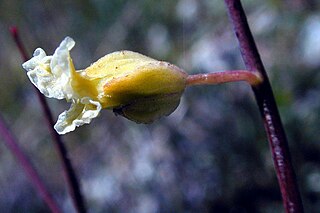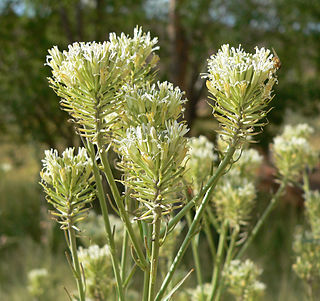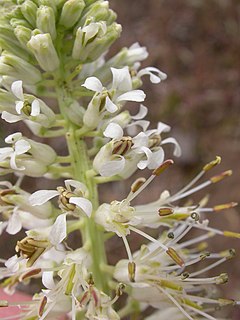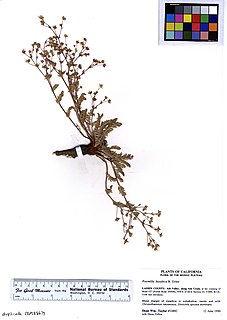
Echinacea laevigata, the smooth purple coneflower, is an Endangered Species Act federally listed endangered species of plant found in the piedmont of the eastern United States. Most populations are found on roadsides and other open areas with plenty of sunlight, often on calcium- and magnesium- rich soils.

Thelypodium howellii, the Howell's thelypody or Howell's thelypodium, is a rare plant of the Western United States. It is endemic to a relatively small area on the borders of three western States: Oregon, Nevada, and California.

Myrtle's silverspot is a medium-sized butterfly in the brush foot family (Nymphalidae), an endangered subspecies of the zerene fritillary. It is endemic to California, where it is known from only about four locations just north of the San Francisco Bay Area, including two at Point Reyes National Seashore. Its wingspan is approximately 2.2 inches (56 mm). The upper surfaces of the wings are golden brown with numerous black spots and lines. The undersides are brown, orange and tan with black lines and silver and black spots. Larvae are dark colored with many sharp branching spines on their backs. Myrtle's silverspot is larger and paler than the closely related Behrens' silverspot, which is now limited to the vicinity of Point Arena in Mendocino County.

Streptanthus glandulosus is a species of flowering plant in the mustard family known by the common name bristly jewelflower. It is native to California and southwestern Oregon, where it grows in many types of habitat, including grassland, chaparral, and woodlands. Genetic and other analyses indicate that it is a species complex with ten subspecies which evolved as populations were isolated from each other. The complex includes subspecies previously considered separate species, such as the rare Tiburon jewelflower endemic to the San Francisco Bay Area. Plants in the complex are variable. In general they are annual herbs growing 10 centimeters to over a meter in height. They may be hairless to hairy to bristly. The ephemeral basal leaves have blades borne on winged petioles. Leaves higher on the stem are linear to lance-shaped and clasp the stem at their bases. Flowers occur at intervals along the upper stem. Each flower has an urn-shaped calyx of sepals one half to over one centimeter long which can be most any color from white to yellowish to pink or purple to nearly black. Purple, white, or purple-veined white petals emerge from the tip. The fruit is a straight or curving silique up to 11 centimeters long.
Streptanthus gracilis is an uncommon species of flowering plant in the mustard family known by the common name alpine jewelflower.

Streptanthus longisiliquus is a species of flowering plant in the mustard family known by the common name long-fruit jewelflower. It was first described to science in 2007. It is endemic to northern California, where it is known from Butte, Tehama, and Shasta Counties. It can be found in forest and woodland habitat in mountains and foothills. It is a short-lived perennial herb producing a few-branched stem up to 1.2 to 1.5 meters in maximum height. It is mostly hairless except for some light hairs on the inflorescences and sometimes the leaf petioles. The basal leaves have oval or spoon-shaped blades up to 10 centimeters long, usually with smooth edges. Leaves higher on the stem are oval or oblong and lack petioles, their bases often clasping the stem. Flowers occur at intervals along the upper stem. Each flower has a bell-shaped calyx of sepals which yellow-green at the base and purplish at the tip, measuring under a centimeter in length. The petals emerging from the end are brownish or purplish with greenish bases. The fruit is a flattened, curving silique that can be quite long even for the genus, measuring up to 15 centimeters in length.

Thelypodium is a genus of flowering plants in the mustard family. There are 16 to 20 species, all native to western North America. Thelypody is a common name for plants in this genus.
Thelypodium brachycarpum is a species of flowering plant in the mustard family known by the common names shortpod thelypody and short-podded thelypodium. It is native to parts of northern California and southern Oregon, where it grows in several types of habitat, including alkaline wetlands and serpentine soils.
Thelypodium crispum is a species of flowering plant in the mustard family known by the common name crisped thelypody.
Thelypodium flexuosum is a species of flowering plant in the mustard family known by the common name nodding thelypody. It is native to the Great Basin and surrounding plateau habitat in the northwestern United States, from California and Nevada to Idaho.

Thelypodium integrifolium is a species of flowering plant in the mustard family known by the common names entireleaved thelypody and foxtail thelypodium. It is native to much of the western United States, including the Great Basin and surrounding plateaus and deserts.

Thelypodium laciniatum is a species of flowering plant in the mustard family known by the common name cutleaf thelypody. It is native to western North America, particularly the Great Basin and surrounding plateau and foothill habitat, where it grows on dry rocky cliffs and hillsides in sagebrush and scrub, usually below 2,400 metres (8,000 ft) elevation.

Thelypodium milleflorum is a species of flowering plant in the mustard family known by the common names manyflower thelypody and many-flowered thelypodium. It is native to western North America, particularly the Great Basin and surrounding plateau, desert, and foothill habitat, where it grows in sagebrush and scrub.

Thelypodium stenopetalum is a rare species of flowering plant in the mustard family known by the common names slenderpetal thelypody, slender-petaled thelypodium and slender-petaled mustard. It is endemic to the San Bernardino Mountains of southern California, where it is known from only three or four extant occurrences in moist mountain meadows near Big Bear Lake. Its remaining habitat is considered seriously threatened and the plant is a federally listed endangered species in the United States.
Mimulus hymenophyllus is a species of flowering plant in the lopseed family known by the common names thinsepal monkeyflower and membrane-leaf monkeyflower. It is native to Hells Canyon on the border between Oregon and Idaho in the United States. It has also been reported from Montana.

Potentilla basaltica is a species of flowering plant in the rose family known by the common names Soldier Meadows cinquefoil and basalt cinquefoil. It is endemic to a small area of the Modoc Plateau and Warner Mountains in northeastern California and northwestern Nevada.
Senecio ertterae is a species of flowering plant in the aster family known by the common name Ertter's ragwort. It is endemic to Oregon in the United States.

Xanthisma coloradoense is a species of flowering plant in the aster family known by the common name Colorado tansyaster. It is native to Colorado and Wyoming in the United States.

Physaria thamnophila is a rare species of flowering plant in the mustard family known by the common name Zapata bladderpod. It is native to Texas in the United States, where it is known from Zapata and Starr Counties. The plant is threatened by the loss and degradation of its habitat. It is federally listed as an endangered species.

Podostemum ceratophyllum, commonly known as the hornleaf riverweed, is a species of submerged aquatic plant in the family Podostemaceae. It is native to eastern North America where it grows on hard bottoms in swiftly flowing rivers and streams and is considered a foundation species.














